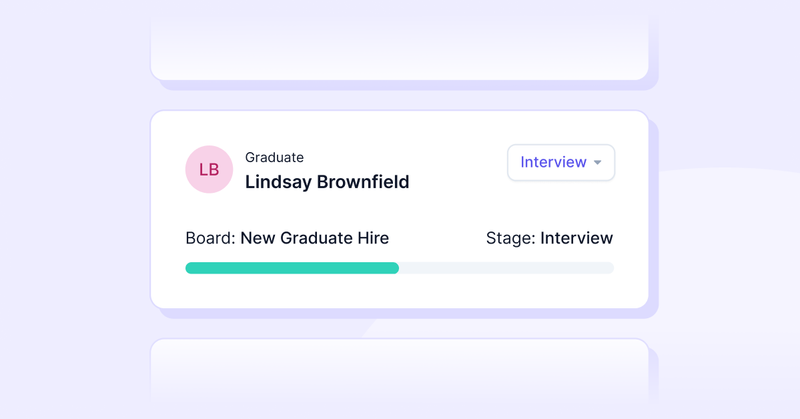Recruiting the right talent is crucial for successful businesses, but it can be a challenging and time-consuming process with many steps involved before you place a candidate in a role.
Each step of this journey, from identifying potential candidates to onboarding successful hires, plays a pivotal role in shaping the success of an organization.
In this comprehensive guide, we'll delve into the intricacies of candidate pipeline management, exploring the challenges, essential skills and best practices that recruitment professionals must master to recruit effectively.
Top challenges of candidate pipeline management
Building and maintaining a robust candidate pipeline poses numerous challenges for recruitment teams:
- Sourcing talent: Identifying and attracting qualified candidates from diverse talent pools requires a strategic approach. In today's job market, recruiters must build up their talent pool using various sources, including job boards such as Indeed, social media like LinkedIn, networking events and employee referrals.
- Candidate engagement: Engaging candidates throughout the recruitment process cultivates positive experiences, strengthens relationships, and bolsters the company's reputation. This approach not only attracts top talent but also improves retention rates and ensures better hiring decisions. However, maintaining consistent communication and personalized interactions with candidates can be challenging, particularly when managing a large volume of applicants.
- Pipeline visibility: Keeping track of candidates at different stages of the recruitment process—from initial application to final offer—requires robust pipeline management tools and systems. Without clear visibility into the candidate pipeline, recruiters may struggle to prioritize tasks, allocate resources effectively and meet hiring goals.
- Talent scarcity: In niche industries or specialized roles, finding qualified candidates with the right skills and experience can be particularly challenging. Recruiters must proactively identify talent gaps, develop targeted sourcing strategies and build relationships with passive candidates to address talent scarcity effectively.
- Time-to-hire: Minimizing time-to-hire is crucial for securing top talent and maintaining a competitive edge. However, delays in the recruitment process, such as prolonged screening or interview cycles, can result in candidate drop-off and lost opportunities.
Essential skills for effective candidate pipeline management
Successful candidate pipeline management requires a combination of skills, ranging from strategic thinking to quality interpersonal communication. Here are some essential skills for recruiters:
- Strategic sourcing: Understanding the organization's talent needs, industry trends, and competitive landscape enables recruiters to develop targeted sourcing strategies. Proactive sourcing techniques, such as talent mapping, Boolean search and passive candidate outreach, help recruiters identify and attract top talent effectively.
- Relationship-building: Building rapport with candidates, maintaining open communication, and providing a positive candidate experience are essential for fostering long-term relationships. Recruiters must demonstrate empathy, professionalism and responsiveness throughout the recruitment process to engage candidates and build trust.
- Pipeline management proficiency: Proficiently using candidate relationship management systems enables recruiters to track candidate interactions, monitor pipeline progress and swiftly identify bottlenecks. Mastery of real-time pipeline visibility empowers recruiters to make data-driven decisions, prioritize tasks effectively and optimize recruitment workflows.
- Data analysis: Analyzing recruitment metrics such as time-to-fill, candidate conversion rates, and source effectiveness, provides valuable insights into pipeline performance. Recruiters must leverage data analytics tools and dashboards to identify trends, measure recruitment ROI and continuously improve pipeline management strategies.
- Adaptability: The recruitment landscape is constantly evolving, with new technologies, regulations and candidate preferences shaping industry trends. Recruiters must keep abreast of emerging best practices, experiment with new sourcing techniques and adapt their strategies to meet changing recruitment demands effectively.
Tools and software for candidate pipeline management
Choosing the right tools and software is essential for optimizing candidate pipeline management. Here are some top solutions tailored for recruiters:
- Applicant tracking systems (ATS): ATS platforms such as Greenhouse, Lever, and Workday Recruiting streamline candidate sourcing, screening, and tracking processes. These systems offer features for job posting, resume parsing, interview scheduling and candidate pipeline management.
- Specialist staffing software: Staffing software like Bullhorn and JazzHR enable recruiters to build and nurture candidate relationships effectively. These systems provide centralized candidate databases, communication tools, and automation features for personalized candidate engagement.
- Recruitment marketing platforms: Recruitment marketing platforms such as SmashFly and Beamery help recruiters attract and engage candidates through targeted campaigns and employer branding initiatives. These platforms offer features for job advertising, talent community management and candidate segmentation.
- Video interviewing tools: Video interviewing platforms like HireVue, Spark Hire, and VidCruiter facilitate remote interviews and assessments, streamlining the interview process and enhancing candidate experience. These tools offer features for live interviews, pre-recorded interviews, and interview feedback collection.
- Analytics and reporting tools: Analytics platforms such as Tableau, Power BI, and Google Analytics provide insights into recruitment metrics and pipeline performance. These tools offer customizable dashboards, data visualization capabilities and predictive analytics for informed decision-making.
- CRM (Customer Relationship Management) software: CRM systems are invaluable for managing candidate pipelines and other business processes too. With CRM software, recruiters can centralize candidate data, track interactions and automate outreach efforts, allowing for more efficient pipeline management and improved candidate experiences. Integrating CRM software into your recruitment process enhances your ability to build and nurture relationships with candidates, ultimately driving better hiring outcomes.
For example, Capsule helps HR and recruitment with:
- Improved task management
- Workflow automation
- Contact management
- Real-time pipeline and project visibility.
Learn more about how a CRM for recruitment can help your business today.
How to use Capsule for candidate pipeline management
In this section we’ll cover how to use Capsule’s features to track interactions, monitor progress, and streamline your recruitment workflows effectively.
Customize your candidate management pipeline
You can create tailored recruitment workflows that align with your specific hiring process using our customizable sales and project pipelines . You can define stages such as "New Applicant," "Screening," "Interview," and "Offer Extended" and easily move candidates through each stage as they progress.
Recruitment agencies can split their candidate hiring and new business acquisition by using Projects for candidate recruitment and the Sales Pipeline to win new business. While in-house HR departments might want to use the sales pipeline for recruitment and the projects for onboarding or other management purposes.
Here’s how to customize your pipeline:
- Click on your name / avatar in the top-right hand corner and click on Account Settings.
- Click on Sales Pipelines.
- On a new Capsule account there will already be a sales pipeline set up for you called Sales Pipeline. Click on this.
- Click Edit Pipeline to rename to something more appropriate like Candidate Pipeline.
- Click on the first milestone. Rename it to something more appropriate. Add a description if you like. Edit your probability of winning and the days until stale. Click Save.
- Repeat step 5 with the other existing milestones. Click add milestone if you need more milestones and click archive to remove those you don’t need from the pipeline.
A demonstration of editing a Pipeline
By using the Sales Pipeline or Project Board you can visualize the recruitment and sales pipelines, identify bottlenecks and ensure that no candidate or sales opportunity falls through the cracks. With our pipelines, you can track the status of each sale and candidate in real-time and prioritize tasks accordingly.
Centralize all candidate information
Create a centralized database to store all candidate information, including resumes, contact details, interview notes and more. Ensure you can customize wherever you are storing all your candidate’s information to easily organize and categorize candidates using Tags or Custom Fields based on their skills, experience and qualifications.
To add tags to a contact in Capsule and edit contact information:
- Navigate to People & Organizations.
- Scroll or search to find the contact you want to edit and click on it.
- Click Edit.
- Fill in or edit the information you want to.
- Click Save.
Example of editing a contact record
By having all candidate information in one place, you can quickly access and review candidate profiles, track their progress throughout the recruitment process and collaborate with team members.
Email integration and communication
We integrate with all email providers allowing you to send emails directly from Capsule. You can also create Email Templates for common communication scenarios, such as interview invitations, application acknowledgments and follow-up emails.
Here’s how to create an email template:
- Click on your name / avatar in the top-right hand corner and click on Account Settings.
- Click on Email Templates.
- Click Add Template.
- Give your template a name.
- Copy and paste your email or write it in the composer. If you want a helping hand you can click the AI Content Assistant button in the bottom right corner for some inspiration.
- Click Insert Fields if there are fields you want to personalize and be automatically populated when sent.
- Click Save.
Example of creating an email template
Task management and reminders
Create tasks and set reminders for important deadlines, interviews and follow-up activities. You can assign tasks to team members, set due dates and receive notifications to ensure that nothing is overlooked. By staying on top of tasks and deadlines, you can maintain momentum in the recruitment process, deliver a positive candidate experience and make timely hiring decisions.
To add tasks to contacts or opportunities, simply navigate to the opportunity or contact, click into it, add all the necessary details and click save. You’ll then be able to see any associated tasks on the opportunity or contact record as well as on the calendar.
Example of adding a task
Hire a CRM
Effective candidate pipeline management is essential for attracting, evaluating and hiring top talent in today's competitive job market. By leveraging strategic sourcing techniques, building meaningful candidate relationships and optimizing recruitment processes, you can build robust pipelines and drive successful hiring outcomes.
Discover how Capsule can help you manage your candidate recruitment processes. Enjoy Capsule’s free starter package or start a 14-day free trial.




